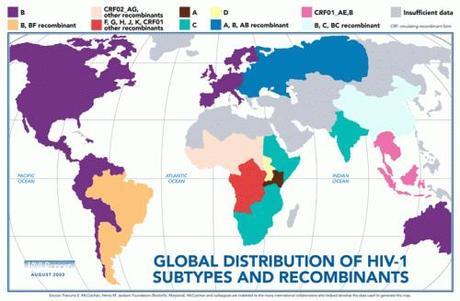
Nice map shows HIV subtypes around the world.
In the US, the Caribbean, most of South America, Europe and Australia, subtype B is predominant. This subtype is very hard to spread heterosexually from woman to man. Such a transmission is possible, but it is not very likely. For instance, even if you had sex with an HIV positive woman, you would have to have sex with her ~700 times over a ~5 year period to even have a 20% chance of getting HIV. Even then, you have an 80% chance (an overwhelming chance) of not getting it. Men in the Subtype B areas are acquiring HIV via receptive anal sex with other men or sharing needles with other IV drug users. Those are mostly the only way transmission is going to men in these regions. Women are getting it from vaginal or receptive anal sex with men and sharing needles with other IV drug users.
In the rest of the areas, the picture is much murkier.
Russia is a mixture of A, B and AB recombinant. Most spread in Russia is going via needle sharing.
In China, B, C and BC recombinant is most prevalent. Much transmission here is also going via needle sharing.
In Southeast Asia, B and CRF_o1AE are common. Much spread here is also going via needle sharing and needle-using men giving it to their wives, but there is also some going via gay male sex, and prostitutes have a high rate of being HIV positive. In addition, there has been a lot of transmission from women to men in this region, mostly prostitutes giving it to their clients. However, this seems to have been associated with vaginal bleeding on the part of the prostitutes. Once that matter is cleared up and the clients use condoms, very little transmission is occurring.
In India and East and Southern Africa, Subtype C is prevalent. Reports indicate that much transmission is occurring heterosexually, either through normal heterosexual sex with either a man or a woman or via prostitutes giving it to their clients. The role of long distance truckers acquiring it from truck stop prostitutes and then spreading around the region is important in both regions. Other than that, little is known about spread in this region, but it does look like Subtype C is being spread pretty easily heterosexually both male to female and female to male, so this subtype is looking like a scary type of HIV.
Subtype D is found in Central Africa and may well be spread heterosexually as easily as Subtype C is.
Subtype A is found in both Russia and coastal East Africa. It seems to be going heterosexually both ways in Africa, but in Russia, there seems to be little heterosexual transmission. This doesn’t really make sense, and it is a mystery that needs to be cleared up.
Brazil is home to Subtypes B and BF recombinant. The type of transmission here is little known, but male homosexual transmission seems to be very important.
In West Africa, CRF_02AG, similar to the SE Asian subtype is the main subtype. Transmission routes are not known, but it looks as if some heterosexual transmission is occurring both ways, however, the rate of heterosexual transmission seems to be much lower than with subtypes C and D.
In West Central Africa, HIV is prevalent but probably not as high as in the C and D areas. A huge variety of subtypes are found here, including subtypes F, G, H, J, K, CRF_01 and various recombinations of these subtypes. There is little information available, but heterosexual transmission both ways seems to be occurring here, higher than with CRF_02AG, but lower than with subtypes C and D.
People keep saying that other subtypes are bound to show up in the US and therefore straight men are bound to be at risk in the future, but it hasn’t really happened, although some different subtypes are occurring in gay men, who sometimes get infected with different subtypes. This is because HIV positive men figure once they are HIV positive, they can fucked all they want to, as they can’t catch HIV now as they already have it. Unfortunately, although they can’t catch HIV per se, they can catch a new strain of it. Infection with more than one strain at once makes HIV more virulent. These cases are nastier and progress more quickly. Death often comes after not too long a time has passed.
